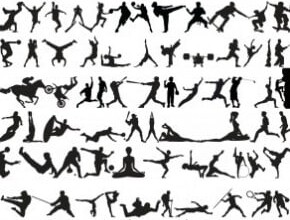 [adrotate group=”1″]The level of obtained technique in aikido is defined by the student’s degree (kyu) and the master’s degree (dan). At the same time, in order to show the level of each aikido fighter, a special system of belts was introduced. White, yellow, blue, brown, and black belts represent levels that may diverse greatly even in judo.
[adrotate group=”1″]The level of obtained technique in aikido is defined by the student’s degree (kyu) and the master’s degree (dan). At the same time, in order to show the level of each aikido fighter, a special system of belts was introduced. White, yellow, blue, brown, and black belts represent levels that may diverse greatly even in judo.
This gradation is very suitable. Knowing which levels the colors of belts correspond to you may accurately define the achievement of aikido ki in mastering this martial art. This is very important for the rookies who ask their senior partner any question. So, how many belts are there in aikido and how do they differ? Let’s have a look.
Aikido Belts Colors Sorted in Order
The order of belt colors in aikido, depending on the style or even school of the same style, may differ significantly. In some dojo, you may find only two types of belts – white and black. Sometimes, you may see intermediate variant, like brown belt symbolizing quick move from rookies’ to masters’ category. Nevertheless, in order not to analyze the belts of each school, let’s look at the maximum gradation of belts in aikido.
Aikikai Aikido Belts System
6 kyu – white belt, primary students level in traditional aikido system. 5 kyu – yellow belt, is presented to attested aikido fighters. 4 kyu – red belt, symbolizes deeper aikido knowledge and techniques compared to the previous level.
3 kyu – green belt, other degree in aikido belt system. 2 kyu – blue belt, shows fairly high level of aikido technique. 1 kyu – brown belt, its owner may hope to get the first master degree after long hour of preparation. 1 – 10 dan – black belt, is worn by every aikido masters whose level is higher than first dan.
Yoshinkan Aikido Belts Order
10, 9 and 8 kyu – white belt in yoshikan schools, in which students attestation starts from 10 kyu. 7 kyu – yellow belt. The first color belt in Yoshinkan Aikido. As the previous degrees, is not used in traditional Aikikai Aikido. 6 kyu – orange belt, another degree in degree gradation in aikido system. [adrotate group=”2″]
5 kyu – green belt, is given to «yoshinkaners», who reached the corresponding level of mastery. 4 kyu – blue belt, the last level before getting senior students degree. 1 – 3 kyu – brown belt, corresponding to senior students aikido degrees. 1 – 10 dan – black belt, high mastery in aikido.
A Secret Etiquette in Aikido Belts Gradation
Due to different traditions in belt system in different aikido schools, a secret rule of major sports event participation was adopted, according to which mastery level of students becomes more obvious.
Aikido ki, having junior students degrees (from white to blue belt), participate with white belts. Those who have brown and black belts, keep them on their thighs. In this way, all the participants may be divided into three groups: junior student, senior student, and a master, which clearly marked with the belt cover.
Aikido Belts with Patches
During any sports event, be it a festival of aikido, exhibition competitions or a seminar of a famous master, one may notice not only the diversity of colorful belts, but also different patches on them. As a rule, these are the Japanese kanjis, which really look very showy. A belt patch is sewn on voluntarily.
The decision to do this is totally individual. Some schools sew on the logo of the club, so this patch doesn’t say about any mastery level of the aikido ki. It is simply a decorative and fashionable way to display club’s individuality. Patches on black belts have significantly deeper meaning.
[adrotate group=”3″]After completing a test for the first master degree, the fighter gets personal black belt with his name being sewn on it with golden thread in Japanese variant. So, the master and his belt become a unity. Technical skills and spirituality blend together, which is shown by the belt with name patch.
Aikido Belts System and Mastery
Unfortunately, many aikido ki’s primary goal is passing a test for a darker belt. They don’t practically try to develop themselves and, as it turns out, there’s nothing “behind” the color of the belt. There’s no effective technique, no understanding of aikido as a martial art system, no self-confidence.
Practicing effective techniques becomes a secondary thing while obtaining green, brown or black belt is goal number one. This is clearly wrong way to go. As a result, it doesn’t matter what color of belt denotes a higher level, as “you get hit not on the belt but on your face.” Each aikido ki has to pay special attention to his growth and think of obtaining new level and belt in the process of mastering his skills.
In other words, one should perfect himself on tatami practice after practice, and grow personally, showing better results gradually. Only after your inner voice tells you that you are ready for next attestation, you may start thinking about changing the color of your belt. And of course, you should read other material about this topic on our portal of learning and self-development.
Learn what kinds of dans exist in aikido, how to motivate yourself for practicing martial arts, how martial arts evolved in time, and read some interesting parables about Eastern martial arts.








